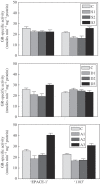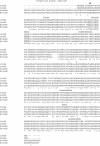Glutathione reductase in leaves of cowpea: cloning of two cDNAs, expression and enzymatic activity under progressive drought stress, desiccation and abscisic acid treatment
- PMID: 17008354
- PMCID: PMC2803587
- DOI: 10.1093/aob/mcl217
Glutathione reductase in leaves of cowpea: cloning of two cDNAs, expression and enzymatic activity under progressive drought stress, desiccation and abscisic acid treatment
Abstract
Background and aims: Reactive oxygen species are frequently produced when plants are exposed to abiotic stresses. Among the detoxication systems, two enzymes, ascorbate peroxidase and glutathione reductase (GR) play key roles. GR has also a central role in keeping the reduced glutathione pool during stress thus allowing the adjustments on the cellular redox reactions. The aim of this work was to study the variations in cytosolic and dual-targeted GR gene expression in the leaves of cowpea plants submitted to progressive drought, rapid desiccation and application of exogenous abscisic acid (ABA).
Methods: Two cowpea (Vigna unguiculata) cultivars, one drought-resistant ('EPACE-1'), the other drought-sensitive ('1183') were submitted to progressive drought stress by withholding irrigation. Cut-off leaves were air-dried or treated with exogenous ABA. Two GR cDNAs, one cytosolic, the other dual-targeted to chloroplasts and mitochondria were isolated by PCR and cloned in plasmid vectors. Reverse-transcription PCR was used to study the variations in GR gene expression.
Key results: Two new cDNAs encoding a putative dual-targeted and a cytosolic GR were cloned and sequenced from leaves of V. unguiculata. Drought stress induced an up-regulation of the expression of the cytosolic GR gene directly related to the intensity of the stress in both cultivars. The expression of dual-targeted GR was up-regulated by the drought treatment in the susceptible cultivar only. Under a fast desiccation, the '1183' cultivar responded later than the 'EPACE-1', although in 'EPACE-1' it was the cytosolic isoform which responded and in '1183' the dual-targeted one. Exogenous ABA enhanced significantly the activity and expression levels of GR in both cultivars after treatment for 24 h.
Conclusions: These results demonstrate a noticeable activation in both cultivars of the antioxidant metabolism under a progressive water stress, which involves both GR genes in the case of the susceptible cultivar. Under a fast desiccation, the susceptible cultivar responded later than the resistant one, suggesting a weaker capacity of response versus the resistant one. Exogenous ABA probably acts on GR gene expression via a mediated signal transduction pathway.
Figures





References
-
- Asada K. (1999) The water-water cycle in chloroplast: scavenging of active oxygens and dissipation of excess photons. Annual Review of Plant Physiology and Plant Molecular Biology 50601–639. - PubMed
-
- Bradford MM. (1976) A rapid and sensitive method for the quantification of microgram quantities of protein utilizing the principle of protein-dye-binding. Analytical Biochemistry 72248–254. - PubMed
-
- Chaudière J and Ferrari-Iliou R. (1999) Intracellular antioxidants: from chemical to biochemical mechanisms. Food Chemistry Toxicology 37949–962. - PubMed

